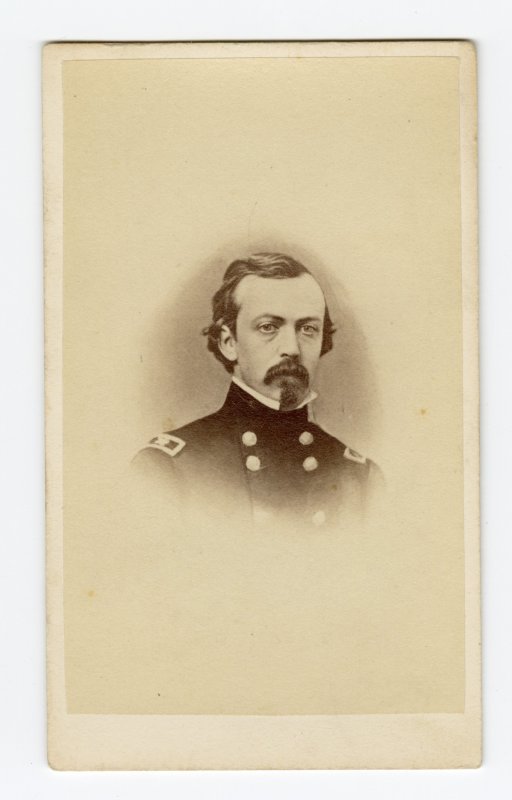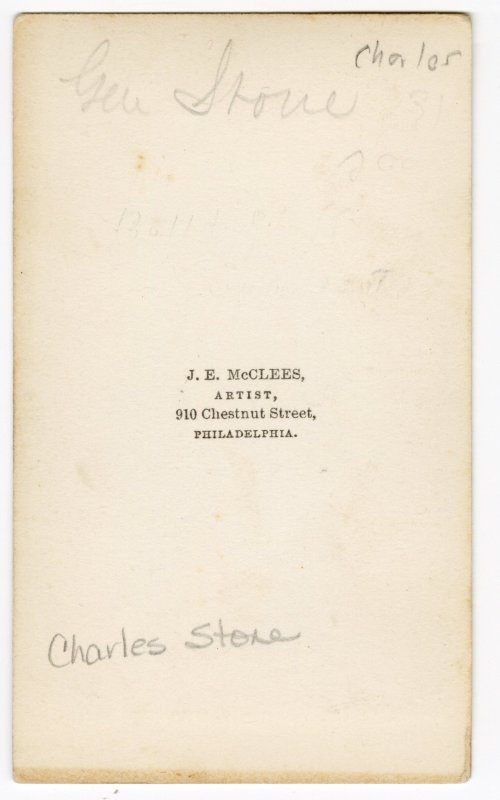General Charles P. Stone
Item CDV-10399
Price: $285.00
Description
Charles Pomeroy Stone was born in Greenfield, Massachusetts on September 30, 1824 and graduated 7th in the West Point Class of 1845. In Mexico, he served as an ordnance officer under Winfield Scott, earning brevets for gallantry at Molino del Rey and Chapultepec in September, 1847.Following the Mexican War, Stone spent 18 months in Europe studying the military systems of France, Prussia, and Sweden, then returned to the U.S. to become Chief of Ordnance for the new Department of the Pacific as of August, 1851. In July, 1853 Stone married Maria Louisa Clary, daughter of Capt. Robert Clary, later General McClellan’s quartermaster. With a daughter, Esther, born in October, 1854 and a son, Charles, Jr., born in November, 1856, Stone decided to leave the army so as to better provide for his family. He resigned shortly after the birth of his son who, sadly, died only five months later.
Working briefly as a banker and gold broker, Stone eventually took a job directing an extensive mineral survey of the Mexican state of Sonora. In December, 1860, while in Washington, DC working on his survey report, Stone was asked by Gen. Scott to return to the army and organize the DC militia for the defense of the capital in the war which Scott felt was inevitable. Stone organized some 30 companies of militia and also oversaw the security arrangements for President-elect Lincoln’s inauguration.
He was named brigadier general of volunteers in August, 1861 and given command of the right flank division of the Army of the Potomac along the line of that river opposite Leesburg, Virginia. On October 21 came the disastrous battle of Ball’s Bluff which resulted in his eventual arrest and the end of his promising army career. Stone was arrested in February, 1862 (in fact more because of political rivalries in Congress than because of the defeat at Ball’s Bluff) and spent six months in prison at Forts Lafayette and Hamilton in New York harbor. No charges ever were filed against him despite his frequent attempts to be granted a court-martial, and he was released the following August with no explanation from the War Department. Assigned to Gen. Nathaniel Banks in New Orleans in May 1863, he arranged the surrender of Port Hudson, then served as Banks’ Chief of Staff until April 16, 1864 when Banks relieved him after a falling out.
Stone’s first wife having died in February, 1863, he married Annie Jeannie Stone (who coincidentally shared the same last name) in November. The following August, General Grant brought him back east and gave him a brigade in the V Corps. Typhoid and an impending nervous breakdown resulted in his decision to resign from the army, effective September 13, 1864.
After the war, Stone worked as a mining engineer in Virginia until an accepting a job as Chief of Staff to the Khedive of Egypt in early 1870. He spent over 12 years in Egypt building up an Egyptian army on western lines and overseeing a dozen major explorations and surveys of the Nile River and surrounding area. With the British takeover of Egypt in late 1882, Stone resigned his position and returned to the United States where he was hired as chief engineer for the construction of the Statue of Liberty. Stone served as Grand Marshal of the statue’s dedication parade on October 28, 1886. Three months later, he contracted pneumonia and died in New York City on January 24, 1887. Charles P. Stone was buried with full military honors at West Point.
Source: American Battlefield Trust


